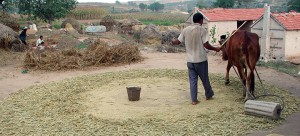
Processing Millet in Eastern Shandong Province in China. Photo: Geoffrey Cunnara cereal grain, rich in protein, fibers, and other micronutrients
The article titled “A Forgotten Group Of Grains Might Help Indian Farmers – And Improve Diets, Too,”published by National Public Radio (NPR) on 9 February 2017, talks about how millet once used to be India’s main staple, but during the Green Revolution in the 1960s, the government encouraged the farmers to grow rice and wheat, cereal grains that produce higher yields.
Now millet seems to have made a “come-back” in India, as “traditional” food, which is more rich in nutrients than rice and wheat, also is more drought-resistant in that it uses less water to grow.
Interested in learning traditional farming practices, or farming practices using millet in the world’s traditional, historic, or even prehistoric societies? Both, general, but also more specific topic searches can be done with eHRAF World Cultures and eHRAF Archaeology, two uniquely structured online databases. The eHRAF databases are different because the documents are not topic-specific, but culture-specific, with individual pages and snippets of texts specific to a topic.
users first must “enter” a culture name before reaching its culture collection, consisting of an number curated ethnographic and archaeological text documents, indexed at the paragraph-level. So instead to finding documents, e.g.,books, journal articles, dissertations, etc. about various cultural uses of millet, in eHRAF users must first decide on a culture name, in a certain region, country, or alternative name, before the texts on a topic can be read.
eHRAF first enters throughabout millet usedcollectionsare unique because their finely curated document collections, only accessible via document collections (ocus first on organizing into with descriptions of cultural practices, including cewhich can haveeHRAF World Cultures, a uniquely structured online database, which focuses culture-then-text specific inon mostly non-western cultures, ethnic and minority groups and indigenous people, includes a plethora of information edata on the specialized cultivation of cereal crops (e.g., maize, millet, rice, wheat); techniques of planting and harvesting (e.g., transplantation, threshing); use of specialized tools, equipment, and machinery; organization of labor and production; etc. The ethnographic texts in eHRAF are indexed with subjects, based on the Outline of Cultural Materials (OCMs). The subjects can be used in Advanced Search to find relevant paragraphs and pages for concepts such as cereal agriculture. The eHRAF Search Example & Methodology section shows how the OCM subject “cereal agriculture” and cultures can be searched in the eHRAF World Cultures.
Click here to learn more about HRAF’s eHRAF World Cultures, a membership-funded online database, click the “Production